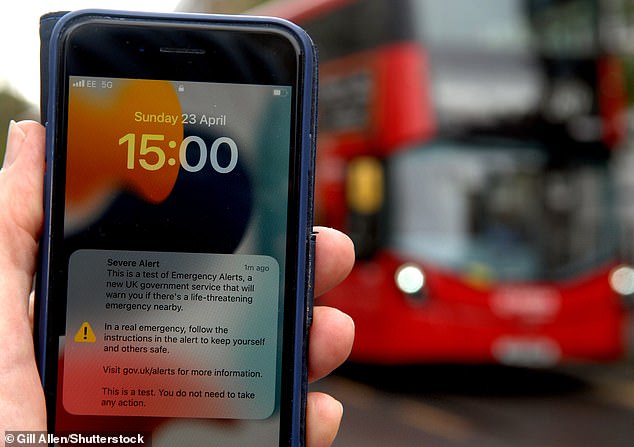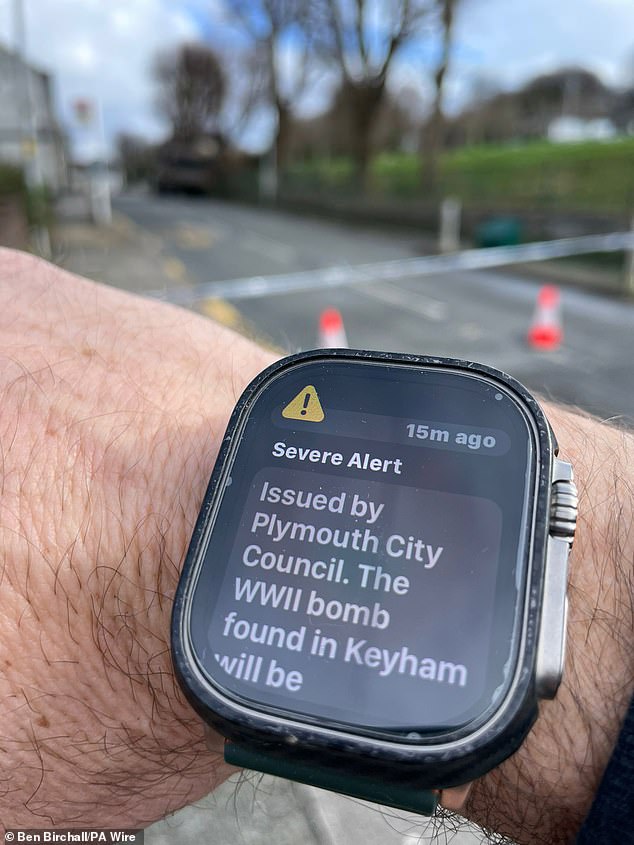The government has revealed the exact time and date that all phones in the UK will blast out an ’emergency alarm’ in the next nationwide test.
The National Emergency Alerts System is used to warn people of an imminent danger to life nearby.
During the upcoming test, all 87 million mobile phones in the UK will vibrate and make a loud ‘siren sound’ for roughly 10 seconds, even if they are set to silent.
Phones will also display a message, stating that the alarm is only a test and not a genuine threat to life.
The next test will begin at around 15:00 BST on Sunday, September 7.
This will be the first time that the Emergency Alerts System has been tested in two years, following the system’s launch in 2023.
Cabinet minister Pat McFadden, Chancellor of the Duchy of Lancaster, says: ‘Emergency Alerts have the potential to save lives, allowing us to share essential information rapidly in emergency situations including extreme storms.
‘Just like the fire alarm in your house, it’s important we test the system so that we know it will work if we need it.’

All phones in the country will blare out an alarm signal later during a test starting at around 15:00 on Sunday, September 7, later this year
Once the alert is issued, all phones in the affected area will make a loud siren-like sound, vibrate, and read out the warning.
The Government does not need to know your phone number in order to send the message, and all phones will automatically trigger the alert.
This announcement follows a recent government commitment to test the system once every two years.
The Government says this is so emergency services can be certain the system works, and so that the public becomes familiar with the alerts.
Ahead of the upcoming test, the Cabinet Office says it will be running a public information campaign to inform people about the test.
This will include targeted outreach for vulnerable groups, such as victims of domestic violence, who may have hidden phones that the alarm test would reveal.
The Emergency Alerts System was introduced in 2023 to quickly inform the public of an impending threat such as severe flooding, wildfires, or extreme weather events.
When it was first tested, the emergency system sent a message to phones which read: ‘Severe Alert. This is a test of Emergency Alerts, a new UK government service that will warn you if there’s a life-threatening emergency nearby.

The Emergency Alerts System is designed to warn people of life-threatening dangers. Its biggest use was during Storm Éowyn in January 2025 (pictured), when alerts were sent to 4.5 million people
‘In a real emergency, follow the instructions in the alert to keep yourself and others safe.
‘Visit gov.uk/alerts for more information. This is a test. You do not need to take any action.’
Since its introduction, the Emergency Alerts System has been used in real life scenarios five times, primarily during major storms when there was a serious risk to life.
The largest ever use saw approximately 4.5 million people in Scotland and Northern Ireland receive an alert during Storm Éowyn in January 2025, after a red weather warning was issued.
The system has also been used in more localised incidents, such as when an unexploded World War II bomb was uncovered in Plymouth.
Glen Mayhew, assistant chief constable for Devon and Cornwall Police, says: ‘By their nature, emergency incidents occur with very little notice. They can develop at speed and across wide areas which puts lives at risk.
‘This system has the ability to send an alert to those whose lives may be at risk, to ensure they can act to help themselves and others.’
Similar systems are already used widely across a number of other countries, primarily for natural disaster preparation.

The alert system was used in Plymouth after an unexploded World War II bomb was uncovered and had to be removed

This comes after Prime Minister Keir Starmer warned that the UK homeland has come under direct threat for the first time in years
Japan has one of the world’s most sophisticated systems, which combines satellite and cell broadcast technology.
This system forms part of a wider scheme called J-ALERT that informs the public in case of earthquakes, tsunamis, volcanic activity, or missile threats.
South Korea frequently uses its national cell broadcast system to alert citizens about issues ranging from weather alerts and civil emergencies to local missing persons cases.
The US has a similar system to the UK that utilises ‘wireless emergency alerts’ to send messages that look like texts with a unique sound and vibration pattern.
The announcement of the UK’s upcoming emergency alert test comes at a time when more people are growing worried about the threat of war.
The latest version of the Government’s defence strategy, published last month, lays out a chilling warning that the UK is no longer safe from military threats.
The report states: ‘For the first time in many years, we have to actively prepare for the possibility of the UK homeland coming under direct threat, potentially in a wartime scenario.’
In a foreword to the report, Prime Minister Keir Starmer adds: ‘The world has changed. Russian aggression menaces our continent. Strategic competition is intensifying. Extremist ideologies are on the rise. Technology is transforming the nature of both war and domestic security.’
